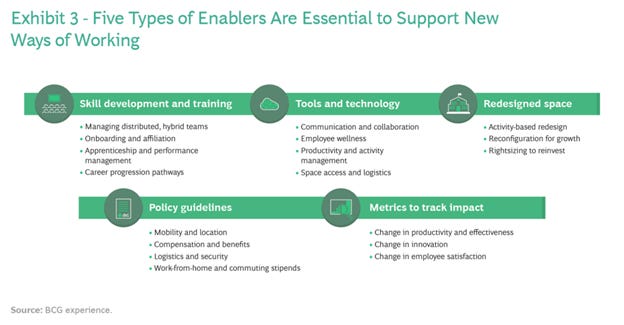Hi, I’m Andy Spence and this is the Workforce Futurist Newsletter about the rapidly changing world of work.
This is the 10th (a mini-milestone) regular article delivered to your inbox every other week. Thanks to all those who have shared these articles, this is appreciated. If you enjoy the content, please like it above and share it with friends. Consider subscribing if you haven’t already 👇
I have been lucky to work with some great people over the years and also in some memorable locations. My powerpointed thinking has been grounded from working in gothic psychiatric hospitals in London to huge train depots in Berlin and cubicled service centres in Bangalore.
Not everyone works in an office, but in the pandemic era, in some cities, up to half of the workforce have been able to work from home.
Before we zoom back to the office too quickly, here are some resources and prompts.
What has changed, apart from the location?
Why is there such an obsession about returning to the office!?
I wonder out loud as I shift away the plates on the kitchen table so I can jump on the Hybrid Work Planning Zoom call and then stare at my boss’s face with a 70 cm close-up view for 90 minutes.
A lot has changed in the last year - personally, professionally, and profoundly.
Before embarking on planning and design, it is worth asking, what has changed in your organisation?
Business strategy - industries are readjusting to the Digital Covid Age. HR work relies on delivering business goals, but has anyone heard from the CEO recently?
Workforce – you haven’t seen some colleagues in real life for 6 months, how are they really doing?
Employer brand – you knew where you stood BC (Before Covid) but will your company have the same pull given that the workforce and labour market has changed?
Physical work facilities – what needs to change to the offices and workplaces to make them safe?
Work location matters, but it’s just one factor in a complex work ecosystem.
And personally, how have you changed and what have you learned?
It’s not hybrid work, it’s work
Next year we will not refer to ‘hybrid work’, it will just be ‘work’.
In planning for a return to the office, what we’re really doing is designing work.
Designing Work means ensuring that activities are aligned with business goals, that the operating model is effective, that we can listen to the workforce and make changes as the business needs change.
In HR, organisational effectiveness should be THE core competency – but it’s a dying art. It requires a particular mindset that includes critical thinking, understanding how ‘systems’ work (in their broadest sense) and then executing. We can call on decades of experience on organisational change as an influx of leaders goes through the same learning curve in a different context.
Recommended ‘return to the office’ guides
The How-To of Hybrid Work - is a sensible and practical article from BCG
Return To Workplace Guide – Lars Schmidt has curated an excellent open-source resource of plans from companies such as Envoy (top-rated report), Hubspot, Reddit, Yelp, Dashlane, Spotify, and Salesforce. If you run a biscuit factory in Leicester, you might not relate to US tech companies - but it’s worth learning from their approaches.
Work Smarter to Live Better - from Ben Willmott CIPD and Howard Lewis Microsoft UK - a PDF report that deserves your attention. And also from Microsoft is The Next Great Disruption is Hybrid. With 160,000 employees and owning some vital workforce technology that we use - this report is well written with good insights. Over 40% of the global workforce are considering leaving their employer this year, so worth thinking of hybrid work in the context of attracting and retaining talent.
If you know anyone in your network who might enjoy this article then please share👇
Enable teams to flourish
All the magic in organisations happens in teams. Yet, much of our management infrastructure is designed around individuals.
A key role for HR is to provide the infrastructure that enables teams to flourish. This includes tools and technology, but also how work gets done.
Here are some resources and considerations for team effectiveness:
Five Principles for Using Technology to Build Successful Organisations – these apply wherever your employers work, from ‘empower workers, don’t spy on them’ to ‘making better decisions on technology’.
A strong predictor of team effectiveness is psychological safety – the belief that one can speak up without risk of punishment or humiliation. In the current environment of distributed work, new tactics will be needed to ensure teams contribute without impediment.
What has covid-10 taught us about remote work? Excellent summary of academic studies from Matt Clancy.
Understanding team dynamics is important, and How Organizational Network Analysis Can Increase Team Collaboration explains how measuring employee’s actual networking behaviour, with permission, can lead to insights that help reduce burnout risk and improve inclusion.
Small things matter – like (re-) establishing team rituals and recognising that small talk for remote workers is important too.
It’s good to talk - Rob Baker has developed job crafting sessions to support teams as they transition back to the office. “with these discussion we invite teams to discuss 4 Ls - what they have loved about working in new ways, what they have loathed, what they are looking forward to in the future and what they have learnt about themselves and colleagues in the last 12 months.”
Look after employee wellness - I found this selection of resources from Jayne Harrison really useful.
Include the fairness principle
Our experience of the pandemic is influenced by age, health, gender, ethnicity, location, wealth, and occupation. In health occupations that are more likely to be frequently exposed to disease, three in four workers (75%) in these roles are women.
Most workforces include so much diversity – along many different axes.
One category is how a worker is contracted from as a contracted employee, a supplier or a freelancer. Whether a worker is working predominately at home, or at an oil refinery, or supermarket – there needs to be some consistency of experience.
Every significant change to an organisation has an inclusion and fairness component.
In planning a return to the office, a question to ask is
Are you treating each category of worker fairly?
Leading the way
In this window of time, you have an unprecedented opportunity to rebuild your organisation. You will never have more resources, support and motivation than you have today. Leaders will set the tone of the organisation, what it stands for and how it operates. This will determine whether businesses flounder, or succeed in the Digital-Covid Age.
Employee of the Week - Salvatore Scumace - “The King of Absentees”
Today the theme is getting back to work, and this story is about an employee who was less keen on going to work. In Catanzaro, Italy, Salvatore Scumace continued to be paid a monthly salary despite not turning up to work since 2005.
Although the Workforce Futurist is fascinated by ‘rethinking work’, it does not in any way support ‘shirking work’. 😉
Good luck with this journey, and do share with me your experiences and insights. Just reply to this email, or connect on Twitter or LinkedIn.








